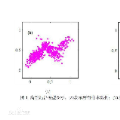Point set registration is an essential step in many computer vision applications, such as 3D reconstruction and SLAM. Although there exist many registration algorithms for different purposes, however, this topic is still challenging due to the increasing complexity of various real-world scenarios, such as heavy noise and outlier contamination. In this paper, we propose a novel probabilistic generative method to simultaneously align multiple point sets based on the heavy-tailed Laplacian distribution. The proposed method assumes each data point is generated by a Laplacian Mixture Model (LMM), where its centers are determined by the corresponding points in other point sets. Different from the previous Gaussian Mixture Model (GMM) based method, which minimizes the quadratic distance between points and centers of Gaussian probability density, LMM minimizes the sparsity-induced L1 distance, thereby it is more robust against noise and outliers. We adopt Expectation-Maximization (EM) framework to solve LMM parameters and rigid transformations. We approximate the L1 optimization as a linear programming problem by exponential mapping in Lie algebra, which can be effectively solved through the interior point method. To improve efficiency, we also solve the L1 optimization by Alternating Direction Multiplier Method (ADMM). We demonstrate the advantages of our method by comparing it with representative state-of-the-art approaches on benchmark challenging data sets, in terms of robustness and accuracy.
翻译:3D 重建和 SLAM 等许多计算机愿景应用软件中, 3D 重建和 SLAM 等, 定点注册是许多计算机愿景应用中的一个基本步骤。 虽然存在许多不同目的的注册算法,但这个专题仍然具有挑战性,因为各种现实世界情景日益复杂,例如重噪音和外部污染。 在本文中,我们提出一种新的概率化基因化方法,以同时匹配基于重尾拉链球分布的多点数据集。 我们采用期望-氧化化(EM)框架来解决LMM 参数和僵硬变异。 我们通过在Lealgebra 中进行指数化绘图,将L1优化作为线性方案编制问题。 该方法最大限度地减少高山概率模型概率密度各点和中心之间的等距离,将高山概率密度密度密度密度各点与中心之间的等距离。 LMMMM 最大限度地缩小了以松动引起的L1 距离。 我们采用期望- 氧化化(EM) 框架来解决LMMM 参数和硬性变换。 我们以L1 优化为直线性方案问题, 通过在LAGeGBBBB 的指数中进行指数绘制, 也通过我们内部数据优化的方法, 的精确化方法,, 以显示我们内部方向的优势化方法 。




